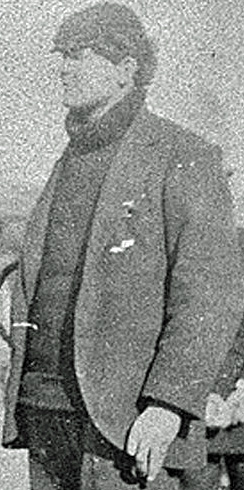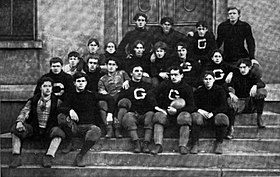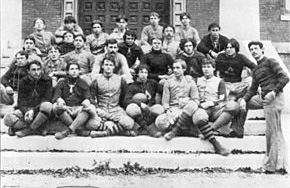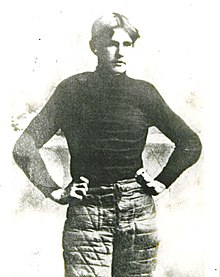Clash of Titans


L: 1895 Auburn-Georgia game (https://alumni.uga.edu/2023/08/21/history-of-the-rivalry-auburn/);
R: Coach Warner on the sideline (https://www.georgiaencyclopedia.org/articles/sports-outdoor-recreation/glenn-pop-warner-1871-1954/)


L: 1896 Georgia starting eleven (University of Georgia Pandora Yearbook, Class of 1897)
R: 1896 Auburn team with John Heisman standing at the right (Auburn Glomeratas Yearbook 1897)

L-R: Captain Rufus Nalley, Coach Warner, Halfback W. S. Cochran
(University of Georgia Pandora Yearbook Class of 1897)
Games featuring a future Hall of Fame coach on each sideline.
November 26, 1896: Auburn vs Georgia
John Heisman vs Glenn "Pop" Warner
Clash of Southern Teams with Yankee Coaches
The Agricultural and Mechanical College of Alabama at Auburn began playing football in 1892. The fledgling program took off when 26-year-old John Heisman became head coach in 1895.
When Dr. Charles Herty joined the Georgia faculty as professor of chemistry in 1891, football was played exclusively by eastern colleges. Dr. Herty had become interested in the game while acquiring his Ph.D. at Johns Hopkins University in Baltimore.
Herty talked up the new sport to his students at Georgia and became the first "trainer" (coach) at the school.
Since Auburn was the only other school in the area that fielded a football team, the two schools decided to play annually on Thanksgiving Day in Atlanta. Thus began the Deep South's Oldest Rivalry.
1895 was an important year for Georgia as well as Auburn. 24-year-old Glenn "Pop" Warner, fresh from a three-year playing career at Cornell, came South in 1895 to become the coach with a salary of $34 per week for 10 weeks. He was so impressive in his initial season, he was given a $6-per-week raise in his second year at Georgia.
When Warner left high school, he had no intention of attending college. Instead, he worked two years as a tinsmith and saved a little money. But he lost it all when he made some bad bets at a racetrack.
Knowing that his father wanted him to become a lawyer, Warner sent his dad a Cornell Law School brochure. Dad responded by sending his son enough money to enroll and live on.
While in law school, Glenn played guard on the Cornell football team. Since he was a couple of years older than his teammates, they nicknamed him "Pop."
After graduating in 1894, Warner played another year on the Cornell team and was named captain. Then he made a decision that affected not only his future but the future of college football. He decided to accept the coaching position at Georgia and practice law in the off season.
Both Heisman and Warner introduced innovations to the fledgling game of football.
Heisman's and Warner's Innovations
Heisman experimented with hidden ball tricks and instituted a shouted signal ("Hike" or "Hep") to trigger the center snap. He also developed a double-lateral pass that spread to other teams. Warner introduced the single and double wing formations, the body blocking technique, and the three point stance for running backs which allowed them to hit the line faster and stronger.
However, those were all in the future. Each coach was learning as much about the techniques of football as he could in his first years at his new job. Warner admitted in his autobiography that he had a full grasp of the guard position he played at Cornell but had to learn on the fly how to coach the other positions. In that regard, Heisman had the edge since he began coaching in 1892 at Oberlin College in Ohio after playing football at Pennsylvania.
If Warner had any doubts that the Northeast was the hotbed of college football just before the turn of the century, what he saw as soon as he walked onto the athletic field at Georgia removed any doubt. "There was no fence around the field, practically no grass on the playing area, and 'quite a few rocks were sticking out of the bare surfaces.' And on the field to greet him were only a dozen players from which to build a team."
But his spirits brightened as more boys came out for the team. "Coach Warner was able to put together a substantial line and a fleet backfield."
Auburn Wins 1895 Contest
The new coaches first clashed on Thanksgiving 1895 in Atlanta, with Auburn claiming a 16-6 victory that reportedly was not as close as the score indicated. Georgia would be much more competitive the following year.
Georgia inadvertantly introduced the huddle during the 1895 game. When the Auburn captain began anticipating Georgia's plays after figuring out the yelled signals, Georgia captain R. B. Nally called his teammates together far behind the line of scrimmage to tell the next play.


L: 1895 Auburn-Georgia game (https://alumni.uga.edu/2023/08/21/history-of-the-rivalry-auburn/);
R: Coach Warner on the sideline (https://www.georgiaencyclopedia.org/articles/sports-outdoor-recreation/glenn-pop-warner-1871-1954/)
Since both teams were undefeated in their three previous games, the winner could claim the 1896 championship of the Southern Intercollegiate Athletic Conference.
Auburn defeated Mercer 46-0, Georgia Tech 45-0, and Sewanee 38-6. Georgia's victims were Wofford 26-0, North Carolina 24-16, and Sewanee 26-0. The scores against the only common opponent, Sewanee, suggested the de facto title game would be tight.
The Atlanta Journal described the atmosphere in the capital of Georgia as fans of both teams flocked to the city for the 1896 Thanksgiving Day game. "Chrysanthemum bedecked youths wandered about the streets this morning, with ribbons flowing from the coat lapels while coaches drawn by gaily decorated steeds could be seen hurrying to and fro under orders of the patrons of the game. Admirers of the knights of the pigskin were in evidence everywhere ..." The writer added, onslaught"No game ever played in the south has ever attracted such general attention nor excited as much interest as this one."
"There was considerable betting about the hotels this morning. ... It is believed that the Georgians will be two to one favorites in the betting by the time the game is called" (begun).


L: 1896 Georgia starting eleven (University of Georgia Pandora Yearbook, Class of 1897)
R: 1896 Auburn team with John Heisman standing at the right (Auburn Glomeratas Yearbook 1897)
The game was played at the baseball field, Brisbane Park, with kickoff at 2:30 PM. The estimated crowd of 8,000 was considered "one of the biggest crowds that ever witnessed a football game in the South." "Every available foot of space was occupied in the grounds, while scores of persons, perched on neighboring housetops, were looking at the field." (Atlanta Journal)
Admission was one dollar for carriage space, 50 cents for adults, and 25 cents for children.
The sun broke out of the clouds about an hour before kickoff time. Unlike the previous year when the game was delayed an hour by an argument over who would be the referee (with the compromise being that both men proposed by the two sides would work the game), the contest started on time (3:30). The field was "a little muddy."

L-R: Captain Rufus Nalley, Coach Warner, Halfback W. S. Cochran
(University of Georgia Pandora Yearbook Class of 1897)
Auburn Steals Georgia's Signals
The first half started as a defensive struggle and kicking duel. With the wind at his back, Georgia's "star quarterback" Richard Von Gammon, who was only 16 years old and a freshman, "drove the pigskin into the air ... toward Auburn's goal. One of his kicks sped 50 yards over the heads of the Auburnites." Auburn was thwarting Georgia's advance because Captain Reynolds Tichenor figured out Georgia's oral signals. "Every time Captain Nalley gave a signal, Captain Tichenor would call out to his men the trick the Georgians were about to play."
So Georgia "dropped behind the line of scrimmage while Nalley gave a signal out of earshot of the Auburn team." This has been described as football's first huddle, but the players themselves considered it just an impromptu meeting to discuss the next "trick." At any rate, "a series of consecutive plays were sprung upon the Alabamians and took them by surprise. The plays were quick and without signals and without a word, the Georgians hammered into the Alabamas, skirted around her ends, bucked between her guard and tackle and carried the ball eight to ten yards at a time towards Auburn's goal. A final plunge and the ball was carried across Auburn's goal line."
Georgia's quarterback and captain, Rufus Nalley, used only hand signals during the onslaught, and Hatton Lovejoy scored the touchdown, which was worth four points. Then Lovejoy kicked the goal for two extra points to give Georgia a 6-0 lead at the end of the 35-minute first half.
Georgia Recovers Onsides Kick
Warner wrote in his autobiography: "In scouting the Auburn team during the season, I had noted that when they lined up to receive a kickoff, there was only one player—the center—who was up close. He was set 10 yards from the ball. The other players were spread out well behind him.
"Consequently, I had the Georgia players practice a short, dribbled kickoff to the left side of the field. I also placed two of my fastest players out near the left sidelines to beat the Auburn players in getting to the ball.
"Our plans turned out perfectly. The short kickoff, or onsides kick, was made (by Lovejoy) to the left side of the field and one of our Georgia players (Nalley) recovered the ball before any Auburn players could arrive on the scene."
Georgia Runs Reverse
Warner had something else planned for the first offensive series. "I devised a series of plays to be used without a signal if we suceeded in getting the ball on the kickoff. These were trick plays to throw the opposition for a loop.
"On the first play ... the entire team was to be set up on one side of the ball, with the player who had recovered the kick acting as the center, or snapper back. The center would then toss the ball out sidewards to one of the backs who would begin to run toward the side of the field that his teammates had lined up on. This back would then toss the ball to another back who was runing behind the rest of the team as his interference. On the next play of this series, the same play was to be run to the opposite side of the field. This caught the Auburn defense off-guard.
"The Georgia player, who had recovered the ball on the kickoff, then snapped the ball back to a back and we were off to the races.
"This trick play netted 25 yards on the first play. And before the Auburn boys had recovered, the same play was made to the left side and went for a touchdown. Following our point-after kick conversion, Georgia led 6-0."
Georgia's quarterback and captain, Rufus Nalley, used only hand signals during the onslaught, and Hatton Lovejoy scored the touchdown.
Georgia Adds Another Touchdown
Georgia soon had another touchdown, which was scored by Walter Cothran on an 8y sweep with Gammon taking out the last Auburn defender. Lovejoy converted again. Georgia 12 Auburn 0
Auburn's best weapon was the punt returns of Reynolds Tichenor. One of them almost resulted in injury. He had gone to the ground when a big Georgia lineman jumped at him, knees first. But Tichenor rolled out of the way in the nick of time. "That fellow was very polite," said Tichenor. "We both got up, and he apologized very profusely for having missed me."
Auburn Avoids Shutout
Neither team scored until Auburn finally got on the board in the final minutes after recovering a fumbled punt in Georgia territory. William Williams was shoved across the goal line by his teammates from the , and Tichenor kicked goal. Georgia 12 Auburn 6
Neither team came close to scoring the rest of the second half. Darkness set in, and the game was called three minutes early by consent of both coaches. Georgia was in possession of the ball on Auburn's 25.
Nalley said afterwards, "I think that we won the game by playing steady, straight football, while Auburn relied most too strongly upon her tricks."
Coach Warner: "We had the best team, but our opponents are good players, and we could not afford to let up until the game was finished. I think our team did the best kicking and ran the ends better. It was a splendid game—one of the best I've ever seen."
Within a month of the final game, Warner left Georgia to return to his alma mater, Cornell.
Featured Player
Richard Von Gammon was a 16-year-old freshman when he played for Georgia in 1896.
His name became known across the country the following year when he was seriously injured in Georgia's game against Virginia.
According to a report in the Atlanta Constitution on October 31, 1897, "Gammon was in the crowd and he made a lunge at the player who had the ball. He missed his tackle and was thrown violently to the ground. He fell with a thud, and the strong, heavy men tumbled over on top of him. Some say Gammon's head hit his shoe as he almost doubled when he was thrown. Others claim his head struck the hard ground. The fearful fall stunned Gammon, and he was picked up dazed and half unconscious. He quickly commenced to vomit, and it was seen by those who ran to his assistance that he was badly hurt. He turned white and the color left his features entirely." |
 Richard Von Gammon |
| Von Gammon was rushed to a nearby hospital, where he died at 3:45 A.M. the next day. News of his death spread throughout the South quickly. Football programs at Georgia,Georgia Tech, Mercer, and Auburn voluntarily disbanded. Within days, the Georgia state legislature introduced a bill that outlawed football playing in the state. Both houses of the state legislature passed the bill by a wide margin. The bill needed only the signature of Georgia governor William Y. Atkinson to become law. But then Rosalind Burns Gammon, the fallen player's mother, wrote the following letter to her local state representative: It would be the greatest favor to the family of Von Gammon if your influence could prevent his death being used for an argument detrimental to the athletic cause and its advancement at the University. His love for his college and his interest in all manly sports, without which he deemed the highest type of manhood impossible, is well known by his classmates and friends, and it would be inexpressibly sad to have the cause he held so dear injured by his sacrifice. Grant me the right to request that my boy's death should not be used to defeat the most cherished object of his life.
After hearing of Rosalind Gammon's request, Atkinson vetoed the bill outlawing football.The football clubs that had disbanded reassembled the next fall. On December 18, 1897, representatives from the member schools of the Southern Intercollegiate Athletic Association met in Birmingham to discuss how to make football less violent. | |
References
Between the Hedges: A Story of Georgia Football, Jesse Outlar (1973)
War Eagle: A Story of Auburn Football, Clyde Bolton (1973)
Pop Warner: Football's Greatest Teacher, The Epic Autobiography of Major College Football's Winningest Coach, Edited by Mike Bynum (1993)
The Ghosts of Herty Field, John F. Stegeman (1997)
Rites of Autumn: The Story of College Football, Richard Whittingham (2001)
Bulldog Madness: Great Eras in Georgia Football, Wilton Sharpe (2005)
Echoes of Georgia Football: The Greatest Stories Ever Told (2006)
I Love Georgia/I Hate Florida, Patrick Garbin (2012)
Gridiron Gypsies: How the Carlisle Indians Shaped Modern Football, Tom Benjey (2022)
Between the Hedges: A Story of Georgia Football, Jesse Outlar (1973)
War Eagle: A Story of Auburn Football, Clyde Bolton (1973)
Pop Warner: Football's Greatest Teacher, The Epic Autobiography of Major College Football's Winningest Coach, Edited by Mike Bynum (1993)
The Ghosts of Herty Field, John F. Stegeman (1997)
Rites of Autumn: The Story of College Football, Richard Whittingham (2001)
Bulldog Madness: Great Eras in Georgia Football, Wilton Sharpe (2005)
Echoes of Georgia Football: The Greatest Stories Ever Told (2006)
I Love Georgia/I Hate Florida, Patrick Garbin (2012)
Gridiron Gypsies: How the Carlisle Indians Shaped Modern Football, Tom Benjey (2022)